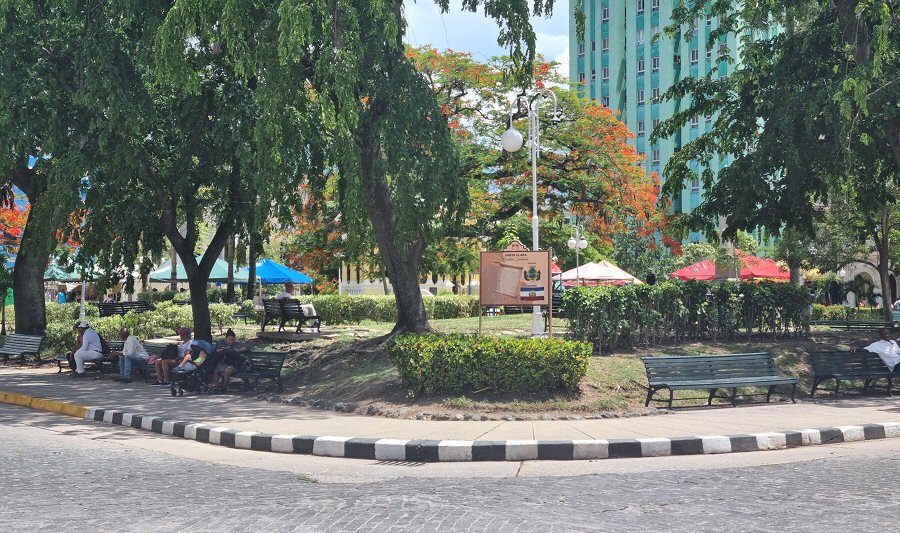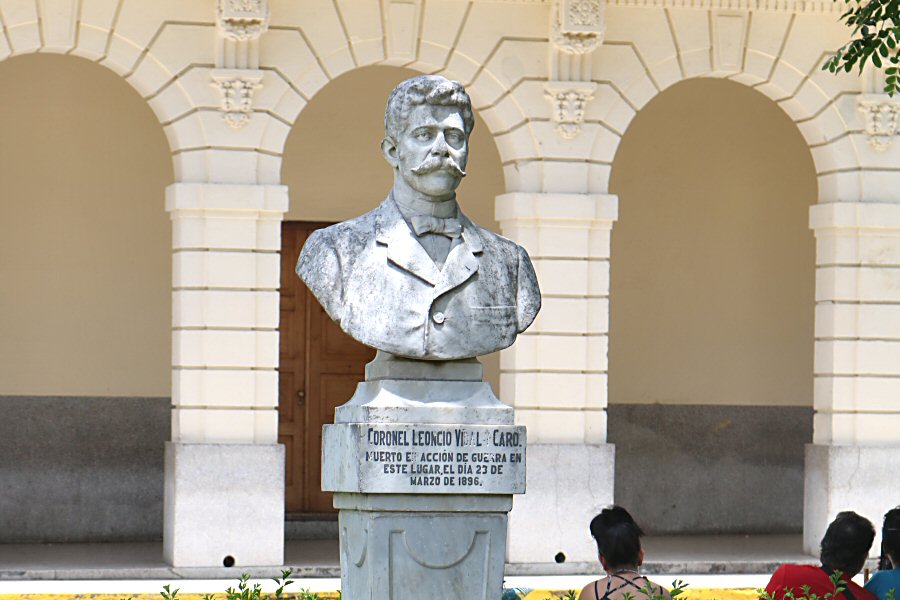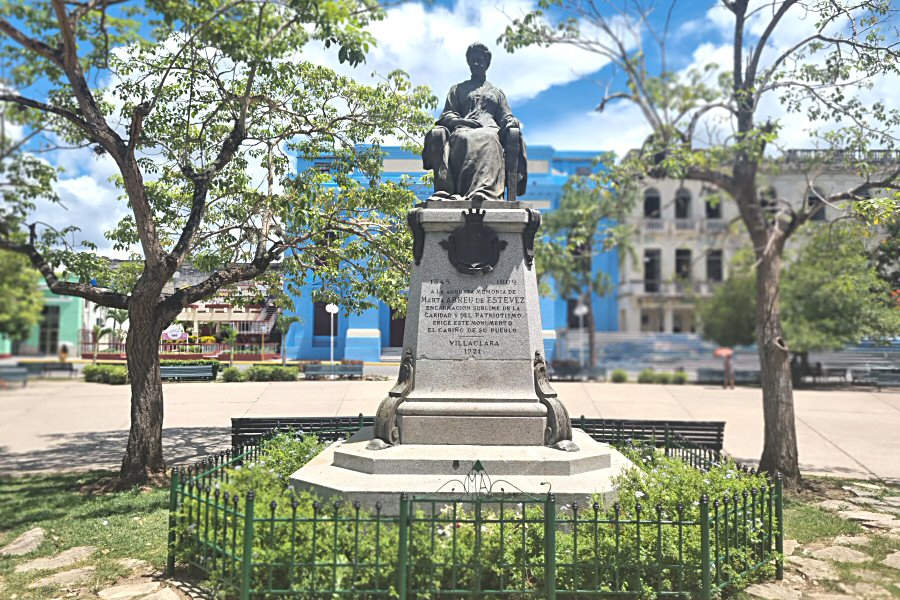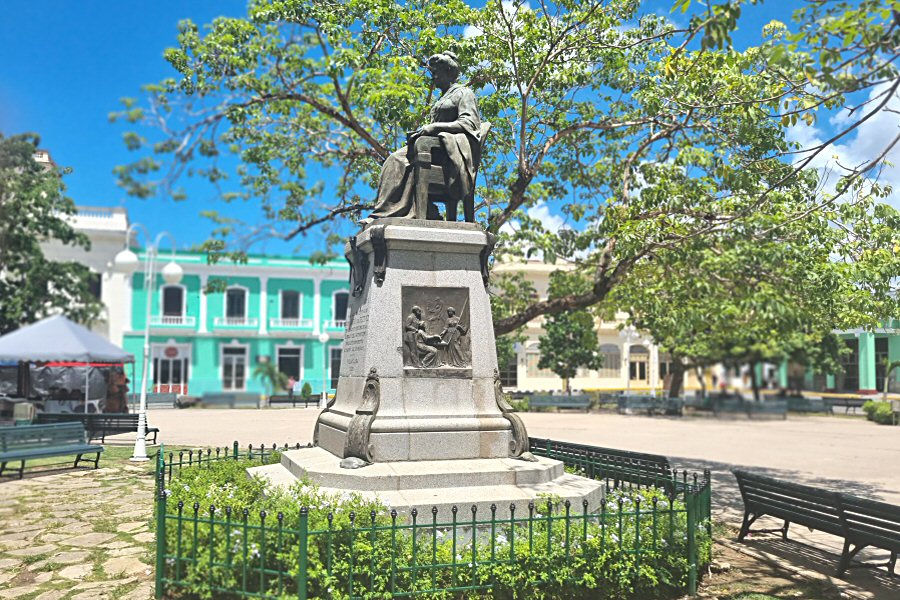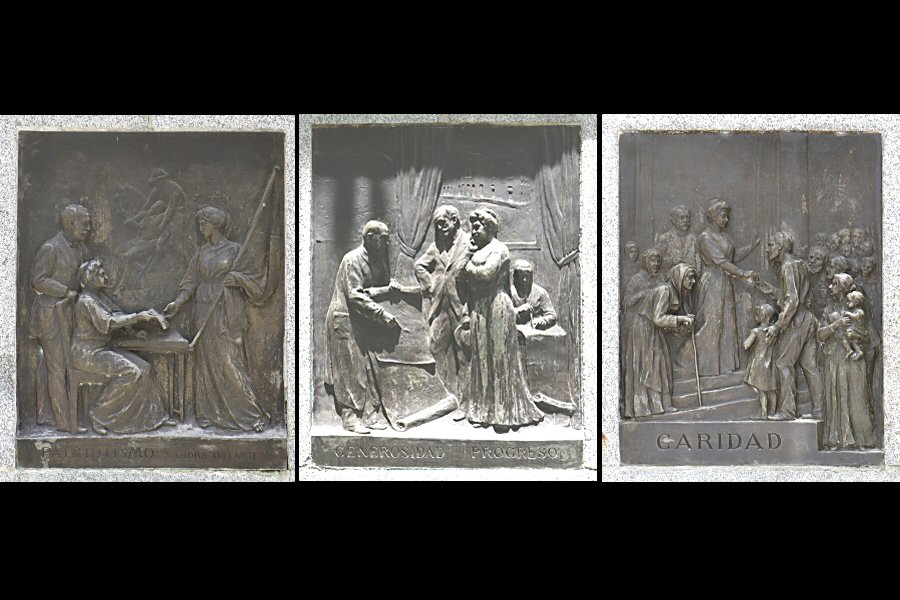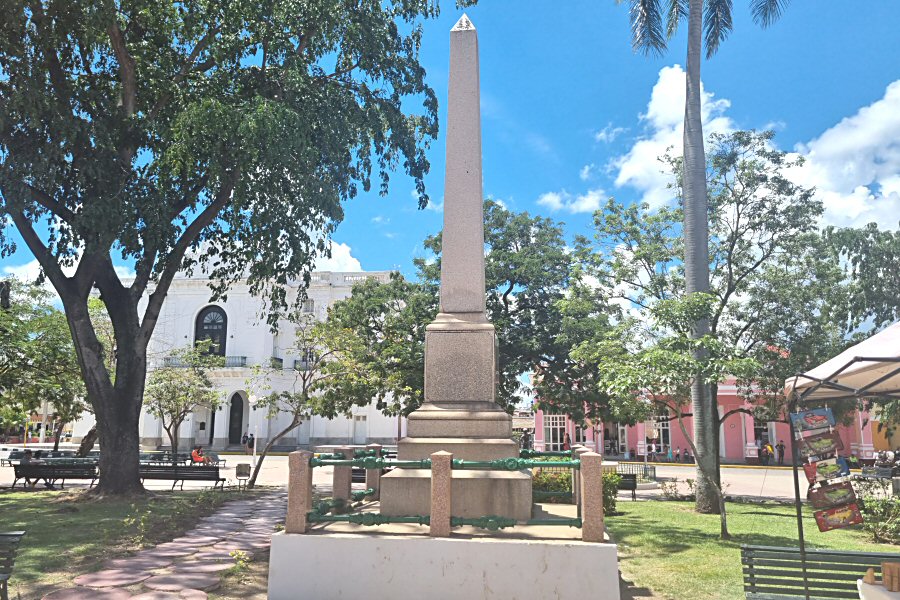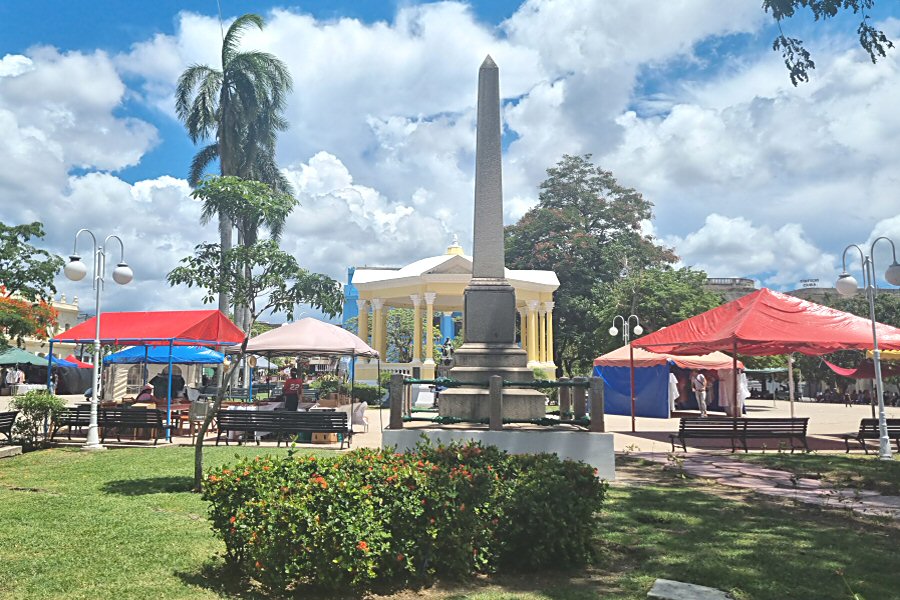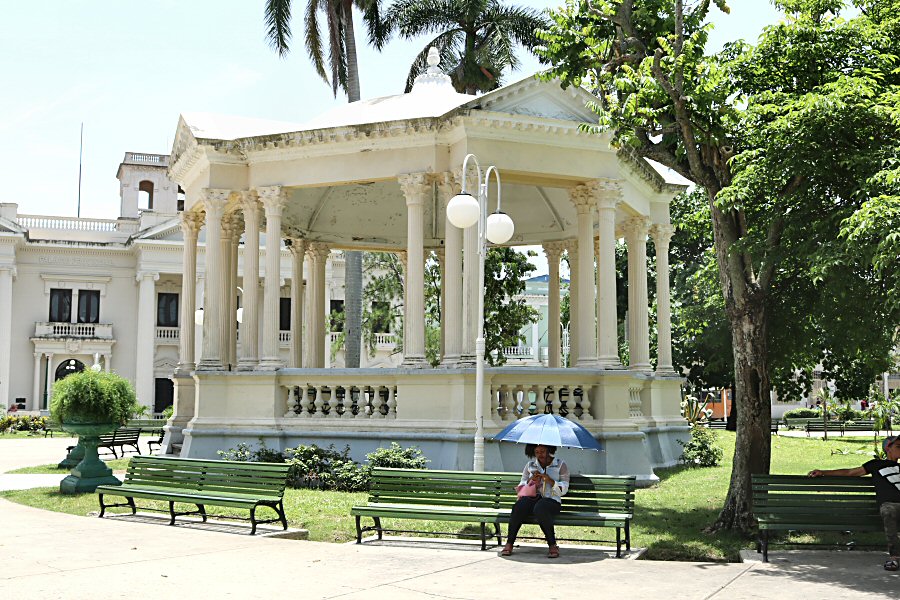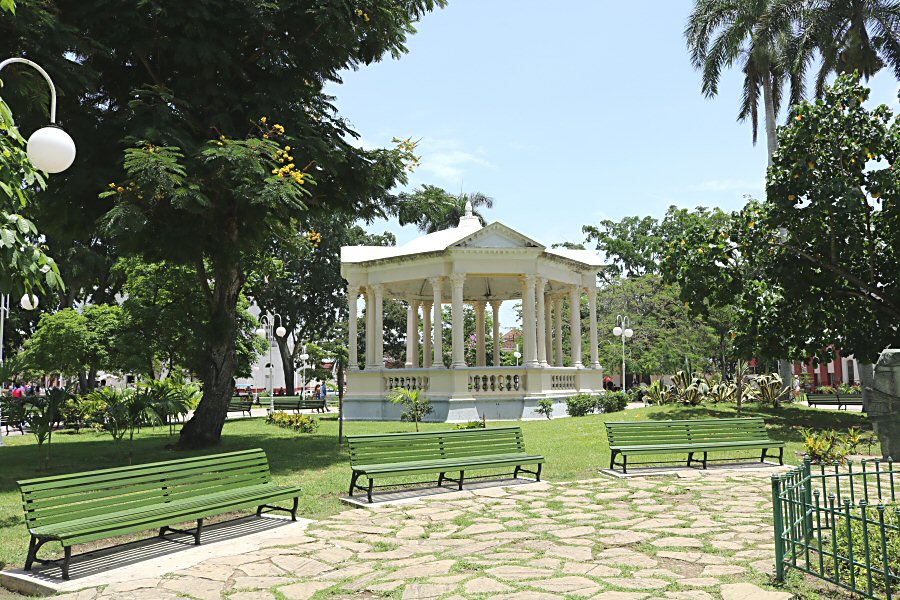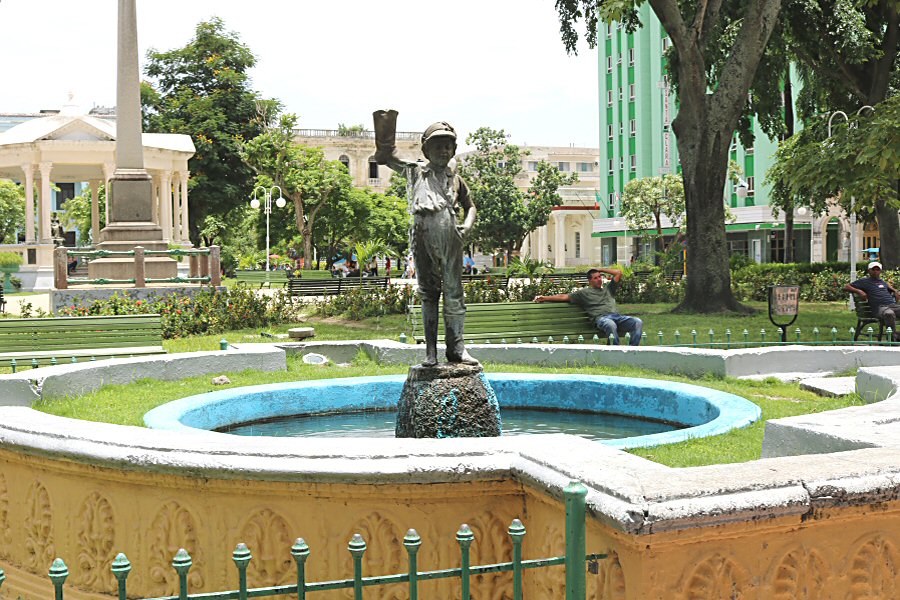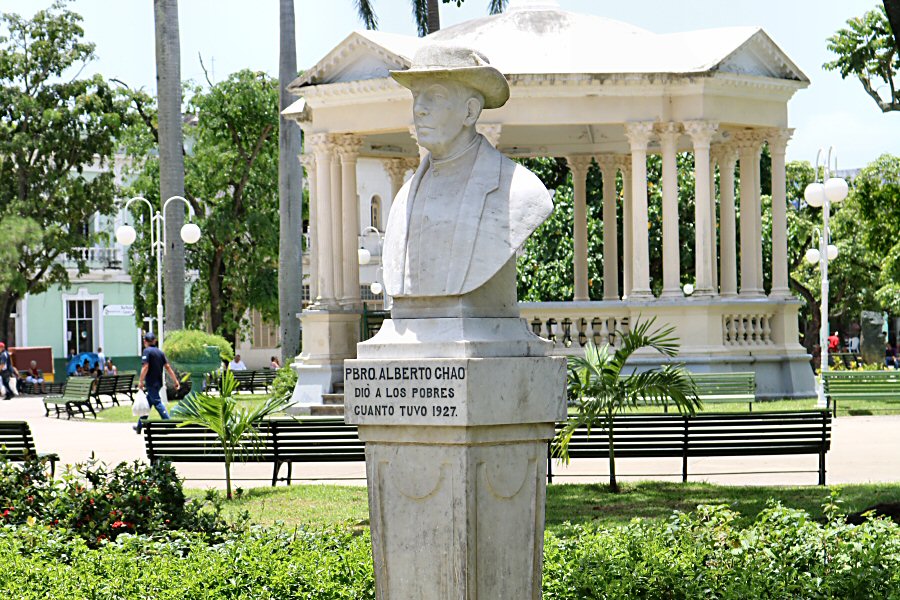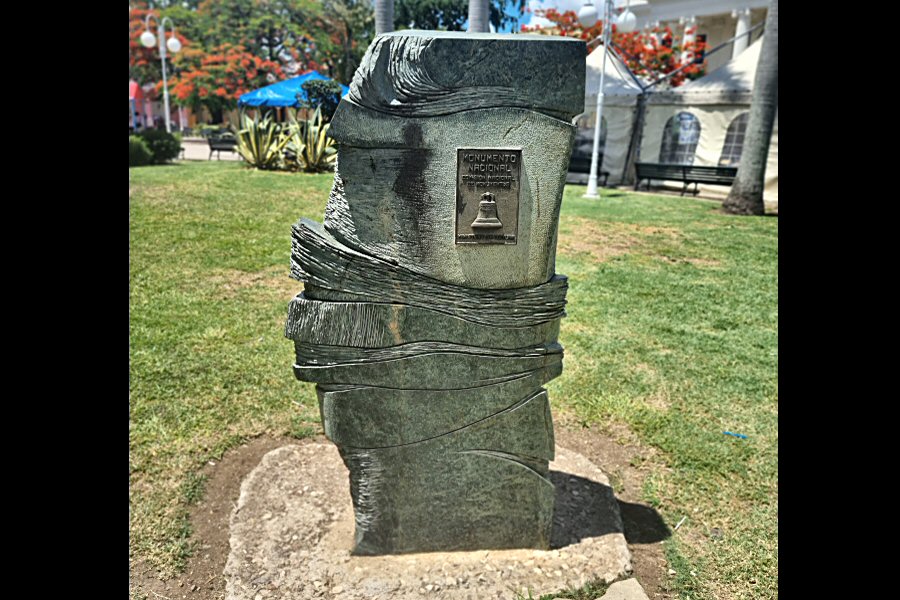ELEMENTS OF THE PARK
Over the years, the park area that is in the shape of a rectangle, has undergone many transformations. The main Parish Church was demolished during the park expansion in 1923. Chao Park, built in 1900, and the Monteagudo Promenade, added to the park in 1904, suffered the same fate. The beloved pergola, opened in 1925, disappeared during the 1959 renovation.
Bust of Leoncio Vidal Caro
Years after the park was named after Leoncio Vidal Caro, a bust of him was unveiled. The ceremony, attended by his widow, friends, and the public, also took place in La Farola, where Leoncio is said to have been martyred.
The lamppost (La Farola) is like a symbol of the event, but the exact location of the patriot's mortal fall is unknown.
Monument to Marta Abreu de Estévez
The bronze monument honors the city's benefactor and distinguished patriot Marta de los Ángeles Abreu y Arencibia (1845 - 1909) (after her marriage Marta de los Ángeles Abreu de Estévez). She devoted her fortune to social welfare and public works in Santa Clara. She contributed numerous financial resources to the fight for Cuban independence. In 1874, she married the doctor and lawyer Luis Estévez y Romero, who also supported her charitable and patriotic activities.
The monument is the work of the French artist August Maillart. It was unveiled on July 15, 1925. It occupies the site of the former presbytery of the main Parish Church which was demolished to expand the park in 1923.
The monument also honors her husband, through the book she holds in her hands, written by Luis Estévez, "Del Zanjón hasta Baire (From Zanjón to Baire)."
Marta Abreu's entire life can be summarized as one of generosity, progress, charity and patriotism. These outstanding characteristics of the philanthropist are reflected in the reliefs on both sides of the monument.
Sculpted in bronze by the French sculptor Auguste Maillard in 1918, the coat arms of Santa Clara is located on the front of the base of the monument.
Obelisk
In the center of the park, there is the obelisk which was inaugurated on July 15, 1886, on the occasion of the 197th anniversary of the founding of the town.
It was erected to perpetuate the memory of the illustrious fathers Juan Martín de Conyedo (1687–1761) and Francisco Antonio Hurtado de Mendoza Veitía (1724–1803).
Juan Martín de Conyedo was an ordained priest, carrying out numerous works for the benefit of the city. He undertook the great task of rebuilding the main Parish Church. He freed the slaves who worked on his projects. He devoted his attention to the education of the children.
Francisco Antonio Hurtado de Mendoza Veitía financed the old San Lázaro Hospital, the La Divina Pastora Church, and the great school Nuestra Señora de los Dolores.
The obelisk was built in Philadelphia under the supervision of Thomas Ricart and is made of gray granite stone brought from Boston. The majority of the cost was paid by Doña Marta Abreu de Estévez and partly borne by the public.
It is 30 feet (9,14 m) high and weighs 17 tons.
It is surrounded by an ornate cast iron and bronze railing which is located between eight artistic pillars, also made of polished red granite.
On the west-facing side, it bears the following inscription: "To the everlasting memory of the virtuous priests and distinguished patricians Juan Martin de Conyedo and Francisco Hurtado de Mendoza. This monument is dedicated by the gratitude of the people of Santa Clara. 1886."
In 1895, the aforementioned monument served as the basis for the construction of a wooden replica of the Eiffel Tower in Paris. It stood 28 meters tall and was decorated with flowers and lights to honor Marta Abreu de Estévez, who had donated the newly inaugurated power plant.
Pergola
The glorieta was built in 1911. It is an area reserved for the municipal band, around which people dance. Since 1902 the municipal band playing vibrant music at 8 pm every Thursday and Sunday.
Fountain of the Boy with the Leaking Boot
There is an interesting fountain with a sculpture in the park, depicting a child with a bare right foot, lifting his right boot and looking inside. Such sculptures, known as the Boy with the Leaking Boots is known to exist in dozens worldwide. Standing approximately 1,2 meters tall, one of the oldest is known to be the one in Sandusky, Ohio, that stands in front of the Porter House hotel on the shores of Lake Erie. It is often designed as a fountain with water spouting from the toe of the boot, as is the case with a similar sculpture located within Parque Leoncio Vidal in Santa Clara.
The initial sculptor and the reason for its creation remain a mystery. Numerous theories have emerged. Some claim it depicts a young Italian newspaper vendor drowning, while others claim it depicts an American army drummer carrying water in his leaky boot to aid his fallen comrades. Others claim it depicts a young firefighter using his boot as a bucket chain, or someone emptying his boot after an accident. It's likely that none of these was the sculptor's intention. The same statue has been known in various places by different names, including "The Boy with the Leaky Boot," "Boy Immigrant," and "The Boy with the Unfortunate Boot."
Colonel Francisco López Leiva who showed heroism in the war of 1895, bought the statue from J. L. Mott of New York, so that it was erected in the Parque Leoncio Vidal in 1925. The cost of its installation amounted to 731,83 pesos. In Santa Clara it is known as The Boy with the Unfortunate Boot.
In 1959, it was destroyed, and 11 years later, Jesús Velazco Fernández rescued its remains and transferred them to the Provincial History Museum. It was reconstructed in bronze by the artist José Delarra and placed in the place it occupies today on July 15, 1989, on the 300th anniversary of the city's founding. This well-executed version of the original is that one that we see in the park today; the original is located in the Provincial History Museum of Villa Clara.
Bust of Alberto Chao
Alberto Chao, defender of the Weyler reconcentrados in the City of Santa Clara, was a Catholic priest. The base of his bust, erected in 1927, bears the inscription "dio a los pobres cuanto tuyo / gave to the poor everything of yours."
Over the years, the park area that is in the shape of a rectangle, has undergone many transformations. The main Parish Church was demolished during the park expansion in 1923. Chao Park, built in 1900, and the Monteagudo Promenade, added to the park in 1904, suffered the same fate. The beloved pergola, opened in 1925, disappeared during the 1959 renovation.
Bust of Leoncio Vidal Caro
Years after the park was named after Leoncio Vidal Caro, a bust of him was unveiled. The ceremony, attended by his widow, friends, and the public, also took place in La Farola, where Leoncio is said to have been martyred.
The lamppost (La Farola) is like a symbol of the event, but the exact location of the patriot's mortal fall is unknown.
Monument to Marta Abreu de Estévez
The bronze monument honors the city's benefactor and distinguished patriot Marta de los Ángeles Abreu y Arencibia (1845 - 1909) (after her marriage Marta de los Ángeles Abreu de Estévez). She devoted her fortune to social welfare and public works in Santa Clara. She contributed numerous financial resources to the fight for Cuban independence. In 1874, she married the doctor and lawyer Luis Estévez y Romero, who also supported her charitable and patriotic activities.
The monument is the work of the French artist August Maillart. It was unveiled on July 15, 1925. It occupies the site of the former presbytery of the main Parish Church which was demolished to expand the park in 1923.
The monument also honors her husband, through the book she holds in her hands, written by Luis Estévez, "Del Zanjón hasta Baire (From Zanjón to Baire)."
Marta Abreu's entire life can be summarized as one of generosity, progress, charity and patriotism. These outstanding characteristics of the philanthropist are reflected in the reliefs on both sides of the monument.
Sculpted in bronze by the French sculptor Auguste Maillard in 1918, the coat arms of Santa Clara is located on the front of the base of the monument.
Obelisk
In the center of the park, there is the obelisk which was inaugurated on July 15, 1886, on the occasion of the 197th anniversary of the founding of the town.
It was erected to perpetuate the memory of the illustrious fathers Juan Martín de Conyedo (1687–1761) and Francisco Antonio Hurtado de Mendoza Veitía (1724–1803).
Juan Martín de Conyedo was an ordained priest, carrying out numerous works for the benefit of the city. He undertook the great task of rebuilding the main Parish Church. He freed the slaves who worked on his projects. He devoted his attention to the education of the children.
Francisco Antonio Hurtado de Mendoza Veitía financed the old San Lázaro Hospital, the La Divina Pastora Church, and the great school Nuestra Señora de los Dolores.
The obelisk was built in Philadelphia under the supervision of Thomas Ricart and is made of gray granite stone brought from Boston. The majority of the cost was paid by Doña Marta Abreu de Estévez and partly borne by the public.
It is 30 feet (9,14 m) high and weighs 17 tons.
It is surrounded by an ornate cast iron and bronze railing which is located between eight artistic pillars, also made of polished red granite.
On the west-facing side, it bears the following inscription: "To the everlasting memory of the virtuous priests and distinguished patricians Juan Martin de Conyedo and Francisco Hurtado de Mendoza. This monument is dedicated by the gratitude of the people of Santa Clara. 1886."
In 1895, the aforementioned monument served as the basis for the construction of a wooden replica of the Eiffel Tower in Paris. It stood 28 meters tall and was decorated with flowers and lights to honor Marta Abreu de Estévez, who had donated the newly inaugurated power plant.
Pergola
The glorieta was built in 1911. It is an area reserved for the municipal band, around which people dance. Since 1902 the municipal band playing vibrant music at 8 pm every Thursday and Sunday.
Fountain of the Boy with the Leaking Boot
There is an interesting fountain with a sculpture in the park, depicting a child with a bare right foot, lifting his right boot and looking inside. Such sculptures, known as the Boy with the Leaking Boots is known to exist in dozens worldwide. Standing approximately 1,2 meters tall, one of the oldest is known to be the one in Sandusky, Ohio, that stands in front of the Porter House hotel on the shores of Lake Erie. It is often designed as a fountain with water spouting from the toe of the boot, as is the case with a similar sculpture located within Parque Leoncio Vidal in Santa Clara.
The initial sculptor and the reason for its creation remain a mystery. Numerous theories have emerged. Some claim it depicts a young Italian newspaper vendor drowning, while others claim it depicts an American army drummer carrying water in his leaky boot to aid his fallen comrades. Others claim it depicts a young firefighter using his boot as a bucket chain, or someone emptying his boot after an accident. It's likely that none of these was the sculptor's intention. The same statue has been known in various places by different names, including "The Boy with the Leaky Boot," "Boy Immigrant," and "The Boy with the Unfortunate Boot."
Colonel Francisco López Leiva who showed heroism in the war of 1895, bought the statue from J. L. Mott of New York, so that it was erected in the Parque Leoncio Vidal in 1925. The cost of its installation amounted to 731,83 pesos. In Santa Clara it is known as The Boy with the Unfortunate Boot.
In 1959, it was destroyed, and 11 years later, Jesús Velazco Fernández rescued its remains and transferred them to the Provincial History Museum. It was reconstructed in bronze by the artist José Delarra and placed in the place it occupies today on July 15, 1989, on the 300th anniversary of the city's founding. This well-executed version of the original is that one that we see in the park today; the original is located in the Provincial History Museum of Villa Clara.
Bust of Alberto Chao
Alberto Chao, defender of the Weyler reconcentrados in the City of Santa Clara, was a Catholic priest. The base of his bust, erected in 1927, bears the inscription "dio a los pobres cuanto tuyo / gave to the poor everything of yours."
